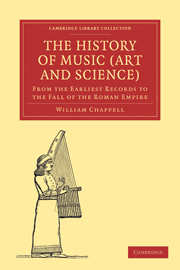Summary
The discussion of ancient and modern science must, in a measure, go hand in hand; for, as our present scale is Greek, so whatever applies to ancient times is equally applicable to the present. No science has more fixed and clearly established fundamental laws than music. The wind will teach them as it plays upon the strings of an AEolian harp; for, although tuned to one pitch, it will cause them to emit sounds of every variety. The same law exists in the natural sounds of a trumpet, horn, or open tube of any kind, and all the notes will follow in the same succession. By blowing into the tube so slowly as just to make the sound continuous, the lowest, or fundamental note, produced by the entire length of the pipe is first heard; then, by gradually increasing the rapidity of the breath, an ascending series of notes will follow; every one of which may be predicted as they rise gradually, higher and higher, up to the extreme pitch that can be obtained from the breath of the mouth. The same rising succession of notes is heard in the harmonic sounds that follow upon one of the long strings of a pianoforte, after the fundamental note, produced by the whole length of string, has been struck, and when the string gradually subdivides itself into smaller and smaller nodes before finally coming to rest. They then follow so rapidly as to seem to run one into the other. From these laws, we may deduce both a perfect Diatonic, and a perfect Chromatic scale from any given note.
- Type
- Chapter
- Information
- The History of Music (Art and Science)From the Earliest Records to the Fall of the Roman Empire, pp. 186 - 251Publisher: Cambridge University PressPrint publication year: 2009First published in: 1874

